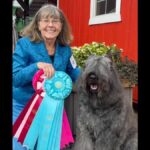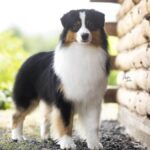Many people are unable to recognize the difference between King Charles Spaniels (English Toy Spaniels) and Cavalier King Charles Spaniels. They are two entirely different breeds, and apart from sharing the same coat colors, have totally separate breed standards, characteristics, and identities.
The Cavalier King Charles Spaniel as we know it today was not given official AKC recognition until 1996. The King Charles Spaniel or English Toy Spaniel, whose history has been documented since the 15th century, has its origins in the courts of Europe, and gained official AKC recognition in 1886. In 2006, only 161 English Toy Spaniel litters were registered with the AKC, while the litter registration for Cavalier King Charles Spaniels exceeded 4,000.
The media often incorrectly describes most Cavalier King Charles Spaniels when they appear in the press as being King Charles Spaniels; this only causes more confusion. It is very alarming for new owners when presenting their puppy to a veterinarian for examination to be told that their beautiful, well-reared King Charles Spaniel is an extremely bad specimen of a Cavalier King Charles Spaniel. This has happened on several occasions, causing the purchaser much distress, and has led to threats of legal action against the breeder.
Some of the reasons quoted have been:
- Because the dog has a domed head, it most probably has hydrocephalus.
- Because the dog has an undershot jaw, it may need corrective surgery in the future.
- Because the dog has fused nails and pads, it may need future surgery.
All these reasons, i.e., domed skull, undershot jaw, and fused toes, are breed-specific to the King Charles Spaniel breed standard.
GENERAL APPEARANCE
The English Toy Spaniel is a compact, cobby, and essentially square Toy dog, whereas the Cavalier King Charles Spaniel is a well-balanced Toy Spaniel. The Cavalier approaches squareness, yet if measured from point of shoulder to point of buttock, it is slightly longer than the height at the withers. The Cavalier should demonstrate a gay temperament combined with true elegance and a look of royalty. He must have a natural appearance, with no trimming, sculpting or artificial alteration of the dog or coat.
SIZE, PROPORTION AND SUBSTANCE
The English Toy’s desirable weight for an adult is 8-14 pounds. It is compact, square in shape, built on cobby lines and sturdy of frame, and solidly constructed. The Cavalier’s desirable adult weight is 13-18 pounds. The Cavalier height is 12-13 inches at the withers, with moderate bone in proportion to size.
HEAD, MUZZLE AND MOUTH
The English Toy head is large in comparison to the size of the dog, with a plush, chubby look. The skull is high and well-domed, and is full over the eyes. The ears are very long, set low and close to the head. The English Toy’s eyes are large, very dark brown or black, and set squarely in-line with the nose.
The Cavalier head is proportionate to the size of the dog, appearing neither too large nor too small for the body. The skull is almost flat between the ears, and the ears are set high but not close on top of the head. The eyes are large, round, and well-set-apart, with dark rims.
The English Toy has a deep, well-defined stop, and the muzzle is very short, with nose well-laid-back. This breed should have a slightly undershot bite, with a square, broad, deep and will turned-up jaw. A wry mouth should be penalized.
The Cavalier stop is moderate, and the length of muzzle from base of stop to tip of nose is about 1 1/2 inches. The Cavalier has a perfect, regular scissors bite. An undershot bite, weak or crooked teeth or crooked jaw are faults in this breed.


NECK, TOPLINE, BODY AND TAIL
The neck on an English Toy is moderate in length and nicely arched. The body is short, compact, square, and deep on cobby lines with a broad back. The breed should be sturdy of frame with good rib and deep brisket. The English Toy tail is docked to 2-4 inches in length and carried at or just slightly above the level of the back. The set of the tail is at the back’s level. Many are born with a shorter or screw tail, which is acceptable. The feathering on the tail should be silky and from 3-4 inches in length, constituting a marked “flag” of a square shape. The tail and its carriage is an index of the breed’s attitude and character.
The Cavalier neck is fairly long, without throatiness, and muscled enough to form a slight arch at the crest. The body is short-coupled, with ribs well sprung but not barreled. The chest is moderately deep, extending to the elbows. Slightly less body at the flank than at the last rib but with no tucked-up appearance. The Cavalier tail is well-set-on, carried happily but never much above the level of the back, and in a constant, characteristic motion when the dog is in action. Docking is optional, but if docked, no more than one-third to be removed. The topline on both breeds is level.


COAT
The English Toy Spaniel is profusely coated, having heavy fringing on the ears, body, and chest, and with flowing feathering on both the front and hind legs, and feathering on the feet. The coat is straight or only slightly wavy with a silken, glossy texture. Over-trimming of the body, feet or tail fringes should be penalized.
The Cavalier coat is of moderate length, silky and free from curl. A slight wave is permissible. Feathering on ears, chest, legs, and tail should be long, and the feathering on the feet is a feature of the breed. No trimming of the dog is permitted. The standard clearly states that specimens whose coat has been altered by trimming, clipping or any other artificial means shall be so severely penalized as to be effectively eliminated from competition.
Blenheim:
The Blenheim color for both breeds consists of a pearly white ground with deep red or chestnut markings. The English Toy standard states it is preferable that there be red markings around both eyes. The Cavalier standard states a clear pearly white ground and calls for the color to be evenly spaced on the head, surrounding both eyes.
Prince Charles or Tricolor:
For the English Toy Spaniel, the black, white and tan color pattern is called Prince Charles, whereas this pattern is called Tricolor on the Cavalier. Both standards read the same, calling for a pearly white ground with evenly spaced black patches, solid black ears, and black face markings. The English Toy states it is preferable that there be black markings around both eyes.
The Cavalier standard states a pearly white ground be clear and the color evenly spaced on the head and surrounding both eyes. Both standards call for rich tan markings over the eyes, inside the ears, and under the tail. The English Toy standard calls for rich color on the face. The Cavalier standard specifically calls for rich tan on the cheeks.
King Charles or Black and Tan:
The black with mahogany tan markings for the English Toy is called the King Charles. The same color pattern for the Cavalier is called the Black and Tan. Both standards read much the same, with the exception of the presence of a small white chest patch about the size of a quarter or a few white hairs on the chest. This is not to be penalized on the English Toy, but any white marks on the Cavalier are a fault.
Ruby:
The Ruby color for both breeds is a rich mahogany red. The English Toy allows for the presence of a small white chest patch about the size of a quarter or a few white hairs on the chest. For the Cavalier, any white marks are a fault.

TEMPERAMENT
The English Toy Spaniel is a bright and interested little dog, affectionate and willing to please. The Cavalier is gay, friendly, and non-aggressive, with no tendency toward nervousness or shyness. Bad temper, shyness and meanness are not to be tolerated and are to be so severely penalized as to effectively be removed from competition.
The English Toy Spaniel is a bright and interested little dog, affectionate and willing to please. The Cavalier is gay, friendly, and non-aggressive, with no tendency toward nervousness or shyness.
PRESENTATION IN THE DOG SHOW RING
The American Cavalier King Charles Spaniel Club, Inc (ACKCSC, Inc.), the AKC parent club, strongly recommends that in the ring, the Cavalier be handled naturally and with a minimum of fuss. The Cavalier is normally shown on a loose or semi-loose lead and is to be self-stacked while free-baiting, with the handler standing. It is totally unacceptable to see handlers on their knees, hand-stacking their Cavaliers, and judges should instruct exhibitors who make this mistake to stand while showing their dogs. Cavaliers are not to be raced around the ring but shown at a moderate trot.
The English Toy Spaniel Club of America does not specify a preference for ring presentation.
These two frequently confused breeds are entirely different in every respect except coat colors. Both parent clubs are adamant that the distinctions be respected and maintained.















